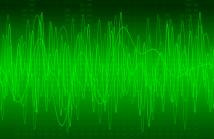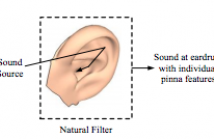
- Read more about Primary-Ambient Extraction Using Ambient Spectrum Estimation for Immersive Spatial Audio Reproduction
- Log in to post comments
The diversity of today’s playback systems requires a flexible, efficient, and immersive reproduction of sound scenes in digital media. Spatial audio reproduction based on primary-ambient extraction (PAE) fulfills this objective, where accurate extraction of primary and ambient components from sound mixtures in channel-based audio is crucial. Severe extraction error was found in existing PAE approaches when dealing with sound mixtures that contain a relatively strong ambient component, a commonly encountered case in the sound scenes of digital media.
- Categories:
 13 Views
13 Views
- Read more about On the Preprocessing and Postprocessing of HRTF individualization based on sparse representation of anthropometric features (slides)
- Log in to post comments
Individualization of head-related transfer functions (HRTFs) can be realized using the person’s anthropometry with a pre-trained model. This model usually establishes a direct linear or non-linear mapping from anthropometry to HRTFs in the training database. Due to the complex relation between anthropometry and HRTFs, the accuracy of this model depends heavily on the correct selection of the anthropometric features.
- Categories:
 7 Views
7 Views
- Read more about On the Preprocessing and Postprocessing of HRTF individualization based on sparse representation of anthropometric features
- Log in to post comments
Individualization of head-related transfer functions (HRTFs) can be realized using the person’s anthropometry with a pre-trained model. This model usually establishes a direct linear or non-linear mapping from anthropometry to HRTFs in the training database. Due to the complex relation between anthropometry and HRTFs, the accuracy of this model depends heavily on the correct selection of the anthropometric features.
- Categories:
 41 Views
41 Views
- Read more about Multi-shift principal component analysis based primary component extraction for spatial audio reproduction (slides)
- Log in to post comments
In spatial audio analysis-synthesis, one of the key issues is to decompose a signal into primary and ambient components based on their spatial features. Principal component analysis (PCA) has been widely employed in primary component extraction, and shifted PCA (SPCA) is employed to enhance the primary extraction for input signals involving the inter-channel time difference. However, SPCA generally requires the primary components to come from one direction and cannot produce good results in the case of multiple directions.
- Categories:
 9 Views
9 Views
- Read more about Multi-shift principal component analysis based primary component extraction for spatial audio reproduction
- Log in to post comments
In spatial audio analysis-synthesis, one of the key issues is to decompose a signal into primary and ambient components based on their spatial features. Principal component analysis (PCA) has been widely employed in primary component extraction, and shifted PCA (SPCA) is employed to enhance the primary extraction for input signals involving the inter-channel time difference. However, SPCA generally requires the primary components to come from one direction and cannot produce good results in the case of multiple directions.
- Categories:
 7 Views
7 Views
- Read more about Natural Sound Rendering for Headphones: Integration of signal processing techniques
- Log in to post comments
With the strong growth of assistive and personal listening devices, natural sound rendering over headphones is becoming a necessity for prolonged listening in multimedia and virtual reality applications. The aim of natural sound rendering is to naturally recreate the sound scenes with the spatial and timbral quality as natural as possible, so as to achieve a truly immersive listening experience. However, rendering natural sound over headphones encounters many challenges. This tutorial article presents signal processing techniques to tackle these challenges to assist human listening.
- Categories:
 28 Views
28 Views
- Read more about A Study on the Frequency-Domain Primary-Ambient Extraction for Stereo Audio Signals (slides)
- Log in to post comments
Primary-ambient extraction (PAE) has been playing an important role in spatial audio analysis-synthesis. Based on the spatial features, PAE decomposes a signal into primary and ambient components, which are then rendered separately. PAE is performed in subband for complex input signals with multiple point-like sound sources. However, the performance of PAE approaches and its key influences in this case have not been well studied so far. In this paper, we conducted a study on frequency-domain PAE using principal component analysis in the case of multiple sources.
- Categories:
 19 Views
19 Views
- Read more about A Study on the Frequency-Domain Primary-Ambient Extraction for Stereo Audio Signals (poster)
- Log in to post comments
Primary-ambient extraction (PAE) has been playing an important role in spatial audio analysis-synthesis. Based on the spatial features, PAE decomposes a signal into primary and ambient components, which are then rendered separately. PAE is performed in subband for complex input signals with multiple point-like sound sources. However, the performance of PAE approaches and its key influences in this case have not been well studied so far. In this paper, we conducted a study on frequency-domain PAE using principal component analysis in the case of multiple sources.
- Categories:
 10 Views
10 Views
- Read more about A Study on the Frequency-Domain Primary-Ambient Extraction for Stereo Audio Signals
- Log in to post comments
Primary-ambient extraction (PAE) has been playing an important role in spatial audio analysis-synthesis. Based on the spatial features, PAE decomposes a signal into primary and ambient components, which are then rendered separately. PAE is performed in subband for complex input signals with multiple point-like sound sources. However, the performance of PAE approaches and its key influences in this case have not been well studied so far. In this paper, we conducted a study on frequency-domain PAE using principal component analysis in the case of multiple sources.
- Categories:
 11 Views
11 Views
- Read more about Time shifted PCA based cue extraction for stereo audio signals (slides)
- Log in to post comments
In spatial audio analysis-synthesis, one of the key issues is to decompose a signal into cue and ambient components based on their spatial features. Principal component analysis (PCA) has been widely employed in cue extraction. However, the performance of PCA based cue extraction is highly dependent on the assumptions of the input signal model. One of these assumptions is the input signal contains highly correlated cue at zero lag. However, this assumption is often unmet.
- Categories:
 9 Views
9 Views